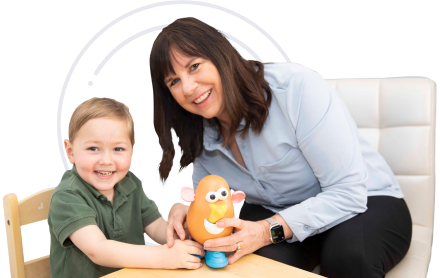Interview with Dr. Temple Grandin on How to Turn Autism Around
Want to Learn how to Increase Talking & Decrease Tantrums in Children with Autism or Toddlers Showing Signs?
Want to start making a difference for your child or clients?

I am so delighted to share this interview with you today. Dr. Temple Grandin wrote the foreword to my newest book Turn Autism Around: An Action Guide for Parents of Young Children with Early Signs of Autism, and I have been a fan of her work for years. When Dr. Grandin was diagnosed with autism in 1949, she was sent to a school for children with speech delays. She can still remember the careful methods that the teachers used to help her begin to hear individual sounds so that she could learn to speak.
By the time kindergarten rolled around, Dr. Grandin was enrolled in the mainstream classroom, but she struggled to learn to read. This is when her mother stepped in to teach her phonics and employ a unique method that brought her slowly into the literary world. Early intervention, led by her mother, made a phenomenal difference in Dr. Grandin’s life and she is a fierce advocate for quality education and therapy for young children with autism.
Dr. Grandin’s mother used a variety of ways to teach and reinforce what she learned at school, including:
Dr. Grandin’s mother used a variety of ways to teach and reinforce what she learned at school, including
- Using mealtimes to enforce waiting.
- Hiring a nanny to teach turn-taking.
- Removing surprises so she knew what to expect.
- Explaining what was going to happen beforehand.
A child with autism can learn enough to be a “bottom-up thinker”, which Dr. Grandin describes as giving a child enough knowledge to function in the real world. From her unique perspective, Dr. Grandin gives her thoughts on how parents and professionals can help children with autism thrive in the outside world.
Today’s Guest
Dr. Temple Grandin is well known to many for her trailblazing work as a spokesperson for people with autism and her lifelong work with animal behavior. Her life’s work has been to understand her own autistic mind, and to share that knowledge with the world, aiding in the treatment of individuals with the condition. Her understanding of the human mind has aided her in her work with animal behavior, and she is one of the most respected experts in both autism and animal behavior in the world.
Dr. Temple Grandin was diagnosed with autism as a child. She went on to earn a degree in psychology from Franklin Pierce College in 1970, followed by a master’s degree in animal science from Arizona State University and a doctoral degree in animal science from the University of Illinois at Urbana-Champaign. She then worked as a consultant to companies with large animal slaughterhouse operations, advising them on ways of improving the quality of life of their cattle. She has published several hundred industry publications, book chapters, and technical papers on animal handling plus 45 refereed journal articles in addition to seven books.
She currently is a professor of animal sciences at Colorado State University where she continues her research while teaching courses on livestock handling and facility design. Her book, Animals in Translation, was a New York Times bestseller and her book, Livestock Handling, and Transport, now has a third edition which was published in 2007. Other popular books authored by Dr. Grandin are Thinking in Pictures, Emergence Labeled Autistic, Animals Make Us Human, Improving Animal Welfare: A Practical Approach, and The Way I See It.
Dr. Grandin has received numerous awards including the Meritorious Achievement Award from the Livestock Conservation Institute, she was named a Distinguished Alumni at Franklin Pierce College and received an honorary doctorate from McGill University, University of Illinois, and Duke University. She has also won prestigious industry awards including the Richard L. Knowlton Award from Meat Marketing and Technology Magazine and the Industry Advancement Award from the American Meat Institute and the Beef Top 40 industry leaders and the Lifetime Achievement Award from The National Cattlemen’s Beef Association. HBO also created a movie about Dr. Grandin’s early life and career with the livestock industry which has won 7 Emmy awards.
You’ll Learn
- Techniques that Dr. Grandin’s mother and teachers implemented to help her learn to speak and read, and then integrate into a mainstream classroom.
- Why Dr. Grandin describes autism as a continuous trait, and why she classifies autism in terms of speaking abilities.
- Dr. Grandin’s greatest concern for today’s young children with autism is very similar to my own concern: the long waitlists for getting into therapy.
- Despite being nonverbal until she was four, Dr. Grandin has an incredible recall of events that happened to her before she could communicate with the outside world.
Resources
Want to Learn how to Increase Talking & Decrease Tantrums in Children with Autism or Toddlers Showing Signs?
Want to start making a difference for your child or clients?
